Photon Factory
Our research
Read more about some of our current and past research projects.
The centerpiece of our laser facility is the ultrafast laser system. This Coherent Legend Elite laser is used to perform laser spectroscopy and to micromachine and microfabricate devices.
The extremely short pulses (100 femtoseconds = 100 x 10-15s) give us a very precise “flash bulb” for time resolved spectroscopy measurements. Because the pulses are so short, they also provide extremely high intensities for cutting and shaping many, many materials, from glass to plastic to metals. At any point in time, we have more than a dozen active projects in the Photon Factory. Five of them are highlighted below:
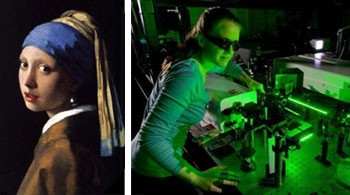
Highlight #1 - Fundamental research
Sarah Thompson (PhD student in Chemical Sciences) is studying how molecules used to make paints have their colour fade from exposure to light.
Her research uncovers the very fast ‘decision making’ processes that these molecules undergo when they are photoexcited. Molecules that retain that energy for longer are more likely to fade than are molecules with efficient mechanisms for dissipating excess energy.
Sarah has found a correlation between the behaviour in the first 100 picoseconds (10-12 s) and the fading rates for the red lake pigments over 100’s of years – it’s like exploring the influence of the early universe on life today.
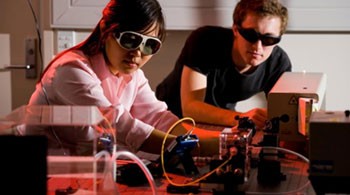
Highlight #2 - Fundamental research
Julie Kho (PhD student in Chemical Sciences) focuses her research upon solar energy harvesting complexes.
She uses nanosecond and ultrafast transient absorption spectroscopies to evaluate the ability of self-assembling porphyrin-fullerene complexes to act as dye sensitisers for photovoltaic devices. The complexes, which are synthesized in Assoc Prof Peter Boyd’s laboratory, exhibit long-lived charge-separated states – essentially they act as molecular batteries.
Julie’s goal is to better understand the relationship between the structure of the complex and the lifetime of the charge-separated state, so that she can help realise the practical, commercial potential of these types of systems for renewable energy harvesting.
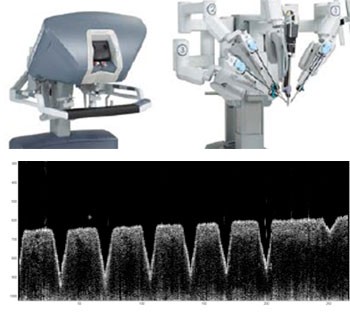
Highlight #3 - Industry research
Lasers are widely used in surgical methods because they can cleanly cut tissue and reduce bleeding. However, some tissues are not compatible with the current types of laser beams used in the surgical setting. They char rather than cut, and can leave tissue damage behind that is detrimental to both long- and short-term recovery and healing.
In the Photon Factory, a team of students and staff are exploring the use of ultrashort pulses for these challenging tissues, in a project funded most recently by Intuitive Surgical. This company is the global leader in robotically-assisted, minimally invasive surgery. Our very promising results may provide a tool for them to achieve better surgical results.
Comment from the company
"The review committee was extremely enthusiastic about your proposal. A method for cutting or machining tissues with reduced tissue trauma, increased precision, and repeatability could open up some very interesting clinical applications." Simon DiMaio, Intuitive Surgical Inc.
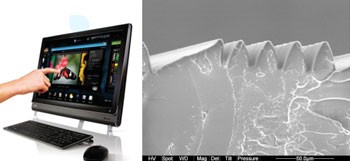
Highlight #4 - Industry research
One of our first commercial projects was such a success, that the Photon Factory engineering student, Peter Hosking, was given a cash bonus by the company.
NextWindow is a New Zealand company, now owned by Smart Technologies. They designs optical touchscreen systems, and were having some technical trouble obtaining the signal quality and reliability needed for the next step forwards for their product.
We designed a new optical component for their system under the specific manufacturing constraints required. We also developed a new technique for manufacturing the component. NextWindow is now mass-producing the part off-shore, and it is being successfully used in their products. We have completed several projects with NextWindow, and a very promising one is in progress now.
Comment from the company
"We are extremely pleased with the result, and I am personally very pleased with the University’s performance ... You have demonstrated that you can deliver solutions within, and to be frank, often ahead of business time frames." Gareth Bell, NextWindow
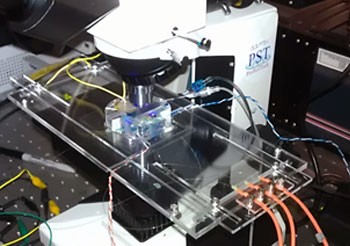
Highlight #5 - Our spin-off company
In 2011, a team of Photon Factory engineering and science students was called together to come up with ideas for how to better sort sperm by sex for the dairy and other agriculture industries. This creative bunch came up with several novel approaches, one of which has been further developed and forms the basis for a Photon Factory spin-off company called Engender Technologies.
The company, co-funded by Auckland UniServices and Pacific Channel, Inc., uses our high-tech lasers as tools for making a new type of device that sort bovine sperm by sex. The goal is to have a commercial product by 2014, and we are optimistic.





